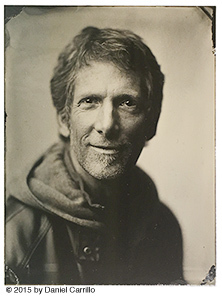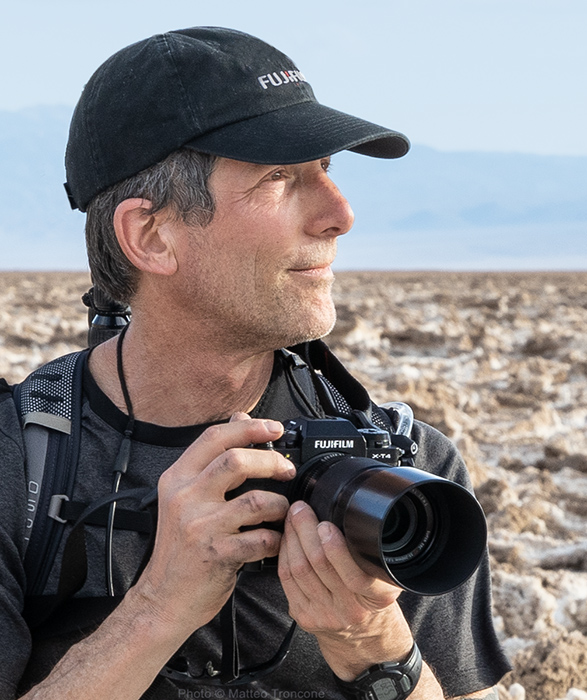Composition and Design are as important in a successful photograph as are light, subject, story and timing. Looking for inspiration outside of your medium is often the key to learning something new. I believe that crossing mediums helps strengthen the random access of ideas that is key to our natural creative process. It’s a bit like loading your conceptual quiver the way a painter loads the palette.

This is a graphic image made with a telephoto lens from a tripod set up across the street.
I set up my desired composition and waited for people to walk into it.
While studying illustration and design in New York in the late 70’s, I began to use an SLR camera to learn composition and to capture reference material. In retrospect, my photographs improved my eye for design and lighting, and inversely, design taught me how to decisively and artfully frame subjects within my camera. Design also taught me how to crop photographs to add impact and mood to the image. Soon, the camera was as much a part of my day as were pad, pencil and subway tokens. I soon realized that my photographs were only going to improve if I tried as many compositions as possible, and learned through editing what didn’t work, and what did. I went through cartons of film (and paper) as I learned to make, develop and print photographs. Experimentation came at an ongoing cost, so it was done with care.

I watched this man looking at discarded objects. I enjoyed seeing how he examined and chose certain things. I shot many frames to capture his gestures, as they add so much energy to this “thirds” based composition.
As today’s digital photographers have almost no limitations other than time, memory space and the cost of gear, my advice is to experiment freely. That doesn’t mean to shoot a ton of redundant frames, but to at least move your camera and body position intuitively to frame your subject with creative variations. (I’ll address this with detail in a future post).
I advocate tight framing of most subjects by getting close, rather than always resorting to telephoto lenses. When you work closer to your subject, other interesting compositions can pop into view that you may never see from a distance.

This scene at SeaTac Airport was shot with a Canon 24-105 zoom.
To limit distortion and frame compress the distance, I shot it at 105mm.
The telephoto is best used for more graphic, flat compositions where wide angle lenses may ‘see’ too much of a scene, or include too many converging lines. It’s a matter of taste. Vary your point of view while watching the edges of the frame for eye-catching artifacts such as circles, fence lines, or awkwardly-cropped objects. Don’t let conventional ‘rules’ stifle your quest for expression. Bend rules, not lines!
A classic composition technique, commonly called the “Rule of Thirds” is often popularized as the ‘correct’ way to compose a photograph. Sometimes it may be. I have one of my camera’s viewfinder set for this grid, and it can be very helpful when I’m working with constantly changing scenes.
While it is true that breaking a space into thirds creates a pleasant balance within the frame, it is a rule to be learned and then modified as needed. Why? Because so many subjects and moments can be more artfully expressed with other compositional options. Alternative compositional ‘tools’ that I use in designing my photographs include: Symmetry, Angles, Convergence, Panoramic Aspect, Color Shapes, Strong Shadows and Selective Detail.

This composition uses the Rule of Thirds as a base. Then, the birds add movement. Note the balance of negative and positive space that enhances the emotional mood of the photograph. It’s one of my favorites and was quite spontaneous.
Training my eye to react and compose is how images like this can happen in a split second.
As any painter will tell you, having a strong foreground element helps create depth, and draws the viewer deeper into the scene. It also adds something relational in size, so that the image has a primary ‘focus’ point. The background can then create a canvas for the main element to rest upon. Visit a gallery or museum and study the compositions of landscape paintings and formal portraits.

Space, division into thirds, and converging angles help bring the viewer deep into this composition. You can almost feel the forward movement of the bow.

Here, the bold and colorful kayak ‘shapes’ rivet the eye, but their lines also lead the viewer towards the distant landscape.

In this panoramic composition, the strongly horizontal shape is itself alluring, but having some colorful action helps prevent the scene from becoming static.
I am asked many questions as I teach my workshops. Some of them are: “Should we always get the perfect composition to fill the frame?” “Is cropping the image afterwards cheating?” “What about Horizontal vs. Vertical compositions “What are some tips for composing square images?” “Is it OK to let subjects run out of frame?” “What’s the best way to crop a portrait?”
I’ll address all of these inquiries (and more) in depth, in upcoming posts. That’s an open invitation for you to return as I dive more deeply into many more creative techniques than will greatly improve your photography. Subscribe so you won’t miss a post. Feel free to comment or ask questions.
Happy shootin’,
Dave
Just fill in the blanks to subscribe for more travel stories and techniques in Photography, Lightroom and Photoshop.
I occasionally send out "The Viewfinder" e-newsletter, and provide free presets and workshop discounts.
I never over-post, share your info, and you can opt out at any time.





Thanks Dave. I’m glad to find you.
Fantastic blog! Thanks for the great information and of course your wonderful photographs!